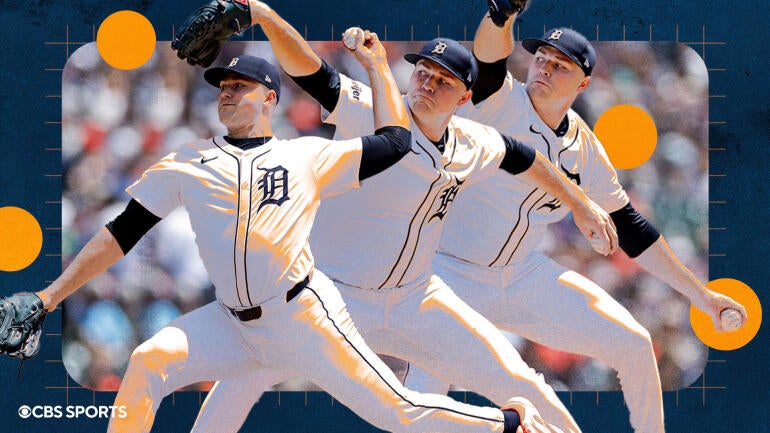

When Detroit Tigers left-hander Tarik Skubal takes the mound Saturday against the Kansas City Royals, he’ll look to progress one of the most dominant pitching stretches in recent memory.
Skubal, whose last start saw him punctuate his first career shutout with a 102.6 mph fastball, will enter his 12th appearance sporting a 2.49 ERA (157 ERA+) and a 13.14 strikeout-to-walk ratio. The latter is the product of this aforementioned stretch. In Skubal’s second start this season, he walked three batters across 5 ⅔ innings of work. Since then, he’s walked three batters in nine starts — all the while punching out 82 batters and tallying a 1.86 ERA and more than six innings per outing.
For some perspective, consider this: Skubal has three different five-game stretches this year in which he’s recorded 46 strikeouts or more. The rest of the majors has one such span combined, with that coming courtesy of Philadelphia Phillies ace Zack Wheeler. Skubal, it’s fair to write, is operating on another level, the kind that could result in him becoming the first pitcher to win consecutive Cy Young Awards since Jacob deGrom in 2018-19. The last American League pitcher to accomplish that feat? Pedro Martinez back in 1999-2000. BetMGM has Skubal as the favorite at -125 odds, ahead of the likes of Max Fried, Garrett Crochet and Hunter Brown.
Time and success have a tendency to flatten narratives and obscure the range of possibilities. Success was never guaranteed for Skubal, let alone this degree of it. He was originally a ninth-round pick in 2018 from Seattle University, hardly a hotbed for elite MLB talent. He developed into a quality prospect, though he was often overshadowed by Detroit’s other talented young arms, like Casey Mize (the No. 1 pick in the same class) and Matt Manning. All these years later, it’s Skubal — not the higher profile prospects — who has turned into the Tigers staff ace.
“I’ve watched Tarik become a better pitcher,” Tigers manager A.J. Hinch told the Detroit Free Press in November, shortly after Skubal won his Cy Young. “There’s the pitcher in him whose stuff is plus, his strike-throwing is plus, his feel for pitching and when to be a dominant first-pitch strike thrower, when to use secondary pitches, that’s grown. The baseball side of it, you can see it evolve as he becomes dominant in every category.
Just how did Skubal go about redefining himself into perhaps the game’s top pitcher? Let’s touch on three particular developments that contributed to his ascent.
1. Delineated pitches
One of the most jarring differences between present day Skubal and the younger version of himself can be captured in his pitch break chart — a four-quadrant representation of a pitcher’s arsenal based on their horizontal and vertical movement. Here’s a look at Skubal’s pitch break charts from 2021 and 2025 (for clarity’s sake, I’m publishing a version of this chart that includes only a single dot for each pitch, as opposed to a dot for every pitch thrown this season):
TruMedia
Treat these images like the ones you used to encounter in grade-school activity books. What are some contrasts you notice? Probably that Skubal has fewer dots, fewer pitches now than back then. Maybe that his fastball has moved into the territory previously occupied by his cutter. How about that his changeup has added both arm-side movement and drop? Or that there’s more space between the dots, particularly in that upper left quadrant?
Let’s focus on those last two points. Whereas a few years back, Skubal’s changeup was basically his sinker, except slower and with less run, now it’s a more defined pitch. In fact, each pitch seems to serve its own purpose rather than running together to create a blob: the fastball features the most rising action, and less run (to the point where on occasion it actually cuts); the changeup has the most fading action away from right-handed batters; and the sinker is a little in between.
There’s not one right answer to what those charts are supposed to look like. Zack Wheeler and Max Fried, to name two successful contemporaries, have more overlap on theirs. The point is, though, that Skubal has clearly made purposeful changes to his arsenal, overhauling his fastball and changeup in particular so that they give him an appreciable different look than he had. As you’ll see, clearly that’s turned out to be a wise use of his time and effort.
2. Altered usage
In addition to refining his pitches, Skubal has also tweaked how he uses his arsenal.
Over the last two decades, MLB as a whole has moved away from the fastball. Whereas close to 60% of pitches in 2008 were either four-seamers or sinkers, that percentage dropped to 54.8% in 2018 and is now down to 47.4% so far in 2025. Teams have grown more fascinated with the swing-and-miss, and that’s meant relying more on designer breaking balls.
Skubal, for his part, has reduced his personal fastball usage from 58.9% as a rookie to 29.3% this year. For the first time in his career, his primary pitch has been his changeup (currently at a 32.1% usage). Should that trend hold over the rest of the year, it’ll be the second time he’s used a non-fastball as his top offering. Back in 2022, his slider led the way with a 30.9% usage rate.
If you take a wide-frame look at Skubal’s usage rates over the years, his arsenal looks a bit like a horse race, with the various pitches jockeying for (and often trading) position:
| Pitch/usage rank | 2022 | 2023 | 2024 | 2025 |
|---|---|---|---|---|
|
Changeup |
4 |
2 |
2 |
1 |
|
Four-seamer |
2 |
1 |
1 |
2 |
|
Sinker |
3 |
4 |
3 |
3 |
|
Slider |
1 |
3 |
4 |
4 |
|
Knuckle curve |
5 |
5 |
5 |
5 |
It’s not unusual for pitchers to develop or lose confidence in this or that offering, leading to shifts in how they approach the opposition. It is fascinating, all the same, that, in the span of just four years, Skubal has seen this much movement among his usage rates. Whereas his changeup has gone from his fourth pitch to his top offering, his slider has made the inverted trek from first to fourth.
Arsenal development is neither linear nor completely predictable.
3. Added juice
Let’s conclude by highlighting the most obvious change to Skubal’s game: his velocity.
From when Skubal first arrived in the majors in 2020 through the 2022 campaign, his fastball sat around 94 mph. He’s since gained oomph on a regular basis. He was up to 95.8 mph in 2023; then 96.9 mph last season; and so far this year, he’s averaging 97.7 mph. Those gains have, perhaps predictably, made Skubal the hardest-throwing left-handed starter in the majors. Open it up to starters of either hand and Skubal ranks second, behind Paul Skenes.
That’s good company to keep, even if right now Skubal looks to be in a class of his own.
This news was originally published on this post .








Be the first to leave a comment